Project work: What is the Greenhouse Effect ?
Objectives: to learn how to reduce our carbon footprint.
to enrich pupil's knowledge on the environmental problems;
to teach pupils to work in groups;
to improve pupil's skills in skimming, listening, making posters;
to develop communicative skills;
to use active lexis on the topic;
to develop critical thinking;
to make the project;
to foster a desire to learn English.
Kolomiiets L.M.
Project work:
What is the Greenhouse Effect and
What does it mean for the Humans on Earth?
Problem: lack of knowledge about reasons of global warming and greenhouse effect.
Motivation: we want to see our streets, parks, forests clean and green, listen to the birds singing, breath fresh air, eat healthy food, drink tasty water, bathe in clean water…
Goals: - to help students to understand how the greenhouse effect works and what the changes it brings about will mean for humans on Earth;
-- to learn how to reduce our carbon footprint.
Objectives: to enrich pupil’s knowledge on the environmental problems;
to teach pupils to work in groups;
to improve pupil’s skills in skimming, listening, making posters;
to develop communicative skills;
to use active lexis on the topic;
to develop critical thinking;
to make the project;
to foster a desire to learn English.
Actions:
-- chose the topic;
-- divided into 5 groups to utilize the Internet or libraries to gather the information:
the 1st group: What are the global warming and the greenhouse effect?
the 2nd group: How does global warming affect us?
the 3d group: What are the greenhouse gasses?
the 4th group: What are the causes of global warming?
the 5th group: Carbon dioxide (positive and negative effects).
--found pictures, studied the information, wrote reports, debated in front of the class with the assigned positions;
--divided into 8 groups to write instructions how to reduce carbon emissions;
-- made posters;
--discussed the facts to reduce own carbon footprint.
Summarizing
Pupils understood the negative effects of the greenhouse and decided to do their best to reduce them.
Group 1. What are The Global Warming and The Greenhouse Effect?
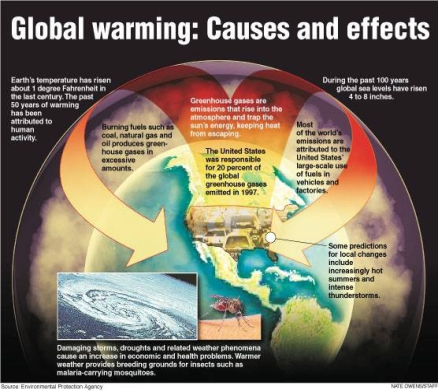
Temperature records have been recorded around the world since the end of the 19th century. According to these records, temperatures on Earth have risen by an average of between 0.5 and 1 degree Fahrenheit over this time. The North Pole has experienced the most significant rise in temperature, around 2.5 degrees Fahrenheit. This warming effect is the result of both greenhouse gas emissions and natural changes in the activity of the Sun.
To understand why the climate would be warming, it is important to understand the Earth's "greenhouse effect." Greenhouse gases, such as carbon dioxide, help keep the earth warm. They float in the atmosphere, the blanket of gases that surrounds the earth, and allow the sun's warming rays through to the earth's surface. When these rays reflect back up, the greenhouse gases keep the warmth from the rays inside the earth's atmosphere. This is how the planet stays warm and allows life to exist, even for the half of the Earth that isn't facing the sun at any given point in time. Scientists believe that climate change is the result of mankind producing too much greenhouse gas. This excessive amount keeps too much of the warmth from the sun bottled up underneath the atmosphere, and the added warmth is causing a number of problems for the climate.
The Earth's temperature is controlled by gases that release into the air in order to absorb heat as it bounces from the Earth's surface into the air. If such gases did not exist, the Earth would be one frozen tundra--but an excess of these gases makes the Earth hotter. Scientists believe that more and more gases are being released by human activities, causing a global greenhouse effect or global warming
The greenhouse effect wouldn't work without the gases in the atmosphere that propel the process. These gases include carbon dioxide, methane, water vapor and nitrous oxide. Combined together, they help keep the greenhouse effect moving.
Group 2. How Does Global Warming Affect Us?
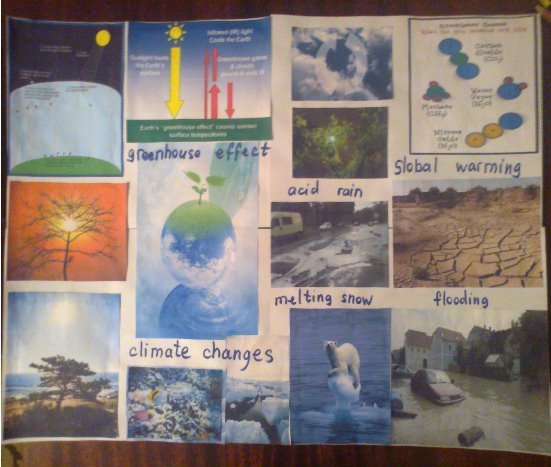
Violent Storms
Global warming is already leading to more violent storms and less predictable weather patterns. The overall number of tropical storms has not increased, but there are more storms strong enough to be called hurricanes. We will probably continue to get bigger storms, which will do more damage to coastal areas.
Climate Shifts
Global warming will destabilize the weather in other ways. In all likelihood, it will change worldwide weather patterns, leading to droughts in some areas and flooding in others
The increased warming will cause the polar ice caps to melt more quickly. This could flood the coastlines of the world and decrease the salinity of the oceans. This could disturb the ocean currents which regulate temperature around to world, leading to drastic changes in local climates.
Global warming will also mess with seasonal water cycles. Many rivers are powered by mountain glaciers which grow in the winter and thaw in the summer, producing seasonal flows. As these glaciers melt, these rivers could decrease or even dry up.
Flora and Fauna
Global warming will have drastic effects on local ecosystems. Most plants and animals are adapted for a certain environment. Generally, each species does well when the temperature is in a certain range, and the seasons work in a regular way. As things like temperature and seasonal precipitation shift, less robust plants and animals are not going to be able to adapt quickly enough. This will result in widespread extinction.
Effects on Humans
It is hard to predict exactly how severely global warming will affect individual locations. The combination of violent storms, rapid changes in local climates, disruption of the water cycle and extinction of plants and animals will probably cause local food shortages and disruption of infrastructure in some areas. The panic and anxiety over global warming will damage the world economy, as will the population squeeze when people in coastal areas are forced to move inland by rising water levels. No matter how you spin it, it's going to take a toll on the economy--at least in the short terms.
Carbon dioxide, methane, nitrous oxide and fluorocarbons are all greenhouse gases. These gases trap heat inside the Earth's atmosphere, contributing to a 0.5 degree increase in the Earth's temperature over the past century.
Greenhouse Effect Greenhouse gases cause the Earth's temperature to rise at alarming rates by trapping infrared radiation from the Earth's surface and emitting some of it back down toward the Earth. This is called the greenhouse effect because of an analogy to the effect produced by glass panes in a greenhouse.
Nitrous Oxide The Earth Encyclopedia estimates that Nitrous Oxide (NO2) concentration in the atmosphere has increased by fifteen percent since the Industrial Revolution. This powerful greenhouse gas occurs naturally, but its increased concentration can be attributed to the mass production of fertilizers.
Carbon Dioxide Carbon dioxide (CO2) is a naturally occurring gas. Plants and trees absorb carbon dioxide, but fail to keep pace with society's rate of industrialization. The burning of fossil fuels, industrial processes and chemical manufacturing all lead to an increase in carbon dioxide in the atmosphere.
Fluorinated Gases Hydroflourocarbons, sulfur hexafluoride and perfluorocarbons are greenhouse gases used as substitutes for chlorofluorocarbons (CFCs). These synthetic fluorinated gases have a high global warming potential, but are emitted in smaller quantities.
Methane The production and transport of coal, oil and natural gas cause an increase in methane (CH4) emissions. Methane gas is also a result of livestock and agricultural waste.
Group 3. What are the greenhouse gasses?
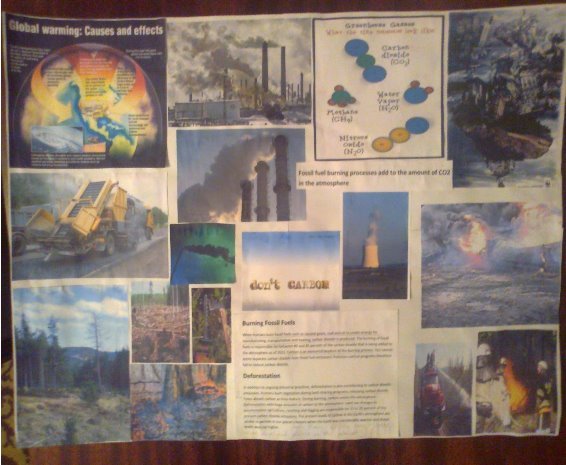
Carbon Dioxide
Carbon dioxide is the main gas that contributes to the harmful, man-made greenhouse effect. CO2 is created by burning fossil fuels, such as oil, natural gas and coal, solid waste and wood
The second largest producer is the transportation sector, including cars, trucks and airplanes, which account for about 33 percent of CO2 emissions. The industrial sector, including petroleum refining, chemical and food production, is the third largest producer of CO2according to Encyclopedia of Earth, CO2 accounts for 82 percent of greenhouse gases.
Deforestation Forests remove and store carbon dioxide. As the population increases, more forests are cut down to make room for urban expansion, to use the wood for building and the land to raise animals. When these forests are cut down or burned, they emit their store of CO2 back into the atmosphere. If we do not replant trees we stand to lose one of our main defenses against CO2. Young, fast-growing trees remove more CO2 than they release
Methane
More than 50 percent of methane emissions are from human-related sources, such as fuel production, animal husbandry, farming and landfill, while the rest are from natural sources, such as wetlands, permafrost, oceans and wildfires. Almost half of all human-related methane emissions come from farm animals and landfills. According to Encyclopedia of Earth, methane accounts for about 9 percent of greenhouse gas emissions. While there is more CO2 emitted each year than methane, methane traps about 20 times more heat than CO2.
Nitrous Oxide (N2O)
Nitrous oxide has both natural sources, mainly oceans and soil bacteria, as well as man-made ones, mostly fertilizers, animal manure, fossil fuel combustion and sewage treatment. Much less N2O is produced yearly than CO2 but nitrous oxide can store 300 times more heat than CO2. Agricultural soil management is by far the largest producer of N2O (It accounts for 5 percent of greenhouse gases). Nitrous oxide is a colorless, non-flammable gas with a slightly sweet odor and is naturally produced by oceans and rain forests. Nitrous oxide is also broken down in the atmosphere by chemical reactions in the presence of sunlight to form smog. Besides agricultural fertilizers, other man-made sources of nitrous oxides are the production of nylon and the burning of coal and organic matter.
.Fluorinated Greenhouse Gases
Fluorinated greenhouse gases, also called high global warming potential (GWP) gases, are the only greenhouse gases that do not occur naturally but made for industrial purposes. The most well known of these gases are chlorofluorocarbons, CFCs, which also deplete the ozone layer. These gases were in cooling and refrigeration processes, like air-conditioning, the electronics industry and in aluminum manufacturing. They are extremely powerful, and can trap 22,000 times more heat than CO2. According to Encyclopedia of Earth, these gases accounted for about 2 percent of greenhouse gases
Group 4. Causes of global warming
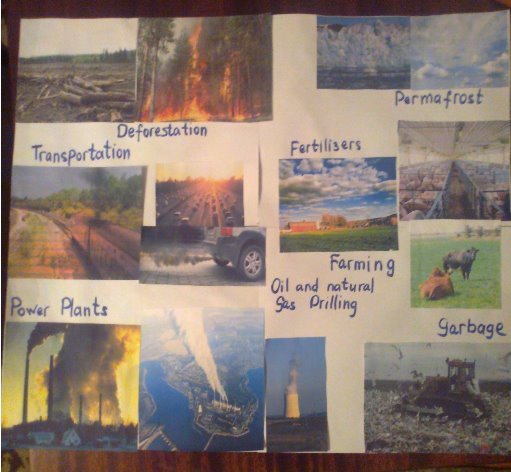
Power Plants
Forty percent of carbon dioxide emissions stem from electricity production. Ninety-three percent of the electric industry emissions result from burning coal. According to the EPA coal-fired power plants, municipal and medical waste incineration account for two-thirds of mercury emissions.
Transportation
Thirty-three percent of emissions come from the transportation of people and goods.
Farming
Industrial farming and ranching releases huge levels of methane and carbon dioxide into the atmosphere. Farming contributes forty percent of the methane and twenty percent of the carbon dioxide to worldwide emissions.
Deforestation
Deforestation to use wood for building materials, paper and fuel increases global warming in two ways -- the release of carbon dioxide during the deforestation process and the reduction in the amount of carbon dioxide that forests can capture.
Fertilizers
The use of nitrogen-rich fertilizers increases the amount of heat cropland can store. Nitrogen oxides can trap up to 300 times more heat than carbon dioxide. Sixty-two percent of nitrous oxide released comes from agricultural byproducts.
Oil Drilling
Burn-off from the oil drilling industry impacts the carbon dioxide released into the atmosphere. Fossil fuel retrieval, processing and distribution accounts for roughly eight percent of carbon dioxide and thirty percent of methane pollution.
Natural Gas Drilling
Touted as a cleaner fuel source, natural gas drilling causes massive air pollution in states like Wyoming; the hydraulic fracturing technique used to extract natural gas from shale deposits pollutes ground water sources as well.
Permafrost
The melting of permafrost releases tons of trapped green house gases which further speeds up the melting of more permafrost. Scientists calculate that approximately five-hundred gigatons of carbon is trapped in the Siberian permafrost alone. A single gigaton equals one billion tons.
Garbage
As trash breaks down in landfills, it releases methane and nitrous oxide gases. Approximately eighteen percent of methane gas in the atmosphere comes from waste disposal and treatment.
Volcanic Eruption
Volcanoes expel large quantities of carbon dioxide when they erupt. Volcanoes have an overall small effect on global warming and an eruption causes a short-term global cooling as ash in the air reflects greater amounts of solar energy.
Group 5. Carbon Dioxide Requirements for Green Plants Plants are the base of our ecosystem. They provide food, shelter, filtration and oxygen. All each plant needs in return is nutrients, soil, water and carbon dioxide. Each plant type---trees, bushes, scrubs, cacti, vines, flowers and grasses---need different levels of carbon dioxide, but receive the gas without any effort by humans.
Photosynthesis
The aim of photosynthesis is to produce sucrose ---a sugar. Essentially plant food, sucrose fuels growth and survival of the plant as well as the animals who eat the plant such as humans.
Trees
Mature trees consume 48 pounds of carbon dioxide a year. The growth enabled by photosynthesis varies by species and age.
Plants
Plants prescribe to the "more is better" philosophy. Greater amounts of carbon dioxide increase plant growth, which is limited only by other photosynthesis requirements.
Oxygen
A single tree produces enough oxygen for two people for an entire year as a byproduct of photosynthesis. Two humans breathe in 4370 pounds of oxygen in a year.
Benefits
Plants need carbon dioxide like humans need oxygen. As humans develop more technology, plants do not discriminate, consuming carbon dioxide produced by both machine and animals, reducing human impact.
Effects
The predicted effects of global warming include the melting of polar ice caps; a significant rise in sea levels; more extreme weather events; a reduction in agricultural land; water shortages; food shortages; loss of rain forests; and more species becoming extinct.
Global warming endangers many including coral reef
If the effects of global warming continue, there could be many adverse effects.
These include a change in weather patterns and a rise in sea levels as ice melts. Many
species of plants and animals may have difficulty surviving in a warmer climate, leading
to extinction, and humans could also be exposed to a greater level of many diseases.
Around the world, people are taking measure such as those aimed at reducing carbon dioxide emissions through using cleaner energy resources in order to improve the situation.
Negative Effects of Carbon Dioxide
Rainforest animals, like all life, are threatened by increases in atmospheric carbon dioxide that contribute to global warming. Excessive carbon dioxide in the atmosphere causes more of the sun's heat to get trapped rather than radiating out into space, raising the overall global temperature of the planet. This global wide warming is often called "climate change."
Negative Effects of Carbon Dioxide on Plants
Plants take in carbon dioxide and breathe out oxygen, but there are many negative effects when there's too much CO2 in the air. Excess carbon dioxide levels in plants can effectively shrink plant growth, limit water evapotranspiration (the plant equivalent of human perspiration) and contribute to global warming.
The Effects of Rising CO2 Levels on Animals
Animal Extinctions
Experts estimate that 35 animal species a day, on average, go extinct in the rainforest due to habitat destruction, pollution and poaching. As rainforests feel the effects of rising levels of carbon dioxide, the number of rainforest animal extinctions will only rise. Animal species that scientists have not yet been able to identify, much less observe and study, are among those rainforest creatures becoming extinct.
Dead Zones
Dead zones refer to places in the ocean with low levels of oxygen. Increased levels of CO2 in the ocean produce these zones. About one-third of the carbon dioxide produced by humans burning fossil fuels ends up in the oceans. More acidic oceans result from this increased CO2. It becomes more difficult for marine animals to take oxygen out of the ocean water to breathe as a result of the higher levels of CO2. This double effect of higher CO2 and lower oxygen means marine life is less likely to find food, reproduce and continue with their way of life.
Loss of Pasture
Rising CO2 levels and the corresponding rise in temperatures mean less grass for grazing by animals. In addition to reducing the quantity of pasture land, the rising levels impact the quality of the remaining land. High CO2 levels affect plant nitrogen and protein content, making the soil unable to sustain the plants animals need for food.
Crop Yields
Expect diminished crop yields with rising levels of CO2. Plants convert CO2 to sugars through photosynthesis, so plant productivity may rise but any gains may be offset by rising temperatures, which lower productivity according to the United States Global Change Research Program. Other problems for crop yields include weeds and insects, both of whom thrive during periods of high CO2.
Loss of Habitat
Rising levels of CO2 impact animal habitats. An example is the big horn sheep of the Sierra Nevada. This animal thrives in a hostile cold mountain environment. That habitat is now threatened by rising temperatures, loss or precipitation and less snow. Its vegetation is not suitable for warmer temperatures and the big horn sheep find their home vanishing. They are not designed for a warm climate and may not survive.
Effects on Humans
Increased levels of carbon dioxide, when inhaled, can lead to negative effects on the respiratory system and, ultimately, the depression of the central nervous system. Initial effects include the feeling of being unable to breathe, called dyspnea. Further exposure can lead to increased pulse rates, headaches, dizziness, sweating, restlessness and disorientation. These symptoms can grow to include decreased mental performance, impaired hearing, nausea and vomiting. Ultimately, exposure to high levels can lead to loss of consciousness and death.
Effects on the Earth and Atmosphere
Carbon dioxide levels are very low in the atmosphere and no foreseeable increase would threaten human breathing. However, an increased level of carbon dioxide has another, entirely different, affect on the atmosphere. Carbon dioxide is the primary contributor to the Earth's greenhouse effect. This effect is similar to an insulating blanket, necessary to maintain a livable temperature on the planet. Without natural greenhouse warming, the average temperature on Earth would plunge below zero every night. However, too much greenhouse warming can do the opposite, known as the enhanced greenhouse effect.
How to Reduce Carbon Emissions
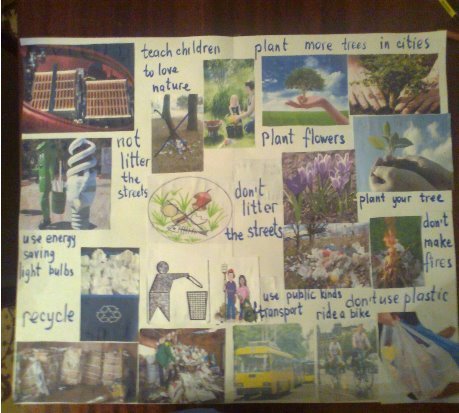
Instructions
1 Reduce carbon dioxide emissions. Walk, take public transportation or ride your bike instead of driving. Buy locally grown or produced foods.
2 Conserve electricity by switching off the TV, computer, radio and lights whenever possible. Unplug electronics from the socket when you are not using them. Use compact fluorescent light (CFL) bulbs, which can reduce energy consumption by approximately 60 percent, in place of incandescent light bulbs. Opt for energy-efficient appliances when shopping. Such products are often marked with the Energy Star label.
3 Plant trees; they contribute to the absorption of excess carbon dioxide. Providing shade and windbreaks, trees also contribute to creating even temperatures for buildings, thereby reducing the energy requirement for heating or cooling.
4 Avoid buying heavily packaged items, decreasing the amount of garbage that you contribute.
5 Keep in mind that heating water requires energy. Reduce your consumption of hot water by washing clothes in cold or warm water. Wait until the dishwasher is full to run it and activate the energy-saving feature if available on your machine. Invest in a low-flow showerhead, which has a lower water flow rate than normal showerheads. Dry your clothes, whenever possible, on a clothesline as opposed to using a mechanical dryer.
6 Reduce nitrous oxide emissions, the majority of which result from agricultural practices. Choose slow-release, low nitrous oxide-emitting fertilizers.
7 Conserve raw materials and energy by recycling or reusing items. Examples include recycling aluminum soda cans and donating or selling old clothing to second-hand stores.
How to Reduce Vehicle Emissions.
1 Ride a bicycle, carpool or choose public transportation. With vehicles acting as a major source of pollution, removing as many vehicles as possible from the road will have the greatest impact.
2 Drive at a moderate speed, no more than 45 mph when possible.
3 Turn your ignition off when waiting in a drive-thru or in congested traffic and do not let your car idle for more than 30 seconds.
4 Take the shortest route possible, and plan your drive so that you do not backtrack or travel out of your way.
5 Keep your vehicle in good operating condition, and maintain it according to the instructions in the vehicle's owner's manual. Have your vehicle inspected on a regular basis, and fix any mechanical problems that arise.
6 Choose a clean-burning fuel, which reduces ozone-forming pollutants by up to 17 percent.
7 Buy a more energy efficient car, one that produces fewer emissions or runs using an alternative fuel. Opt for a newer car when possible; older, used cars release more pollutants into the air.
How to Reduce Carbon Emissions
1 Choose green energy instead of gas, oil or coal. Forms of green energy include geothermal power, solar power, wind power and tidal power. Your current electric company may offer these options or you can call other electric companies.
2 Become a vegetarian, or at least reduce your consumption of beef. Cattle contribute to carbon emissions because they give off methane, which is not good for the atmosphere.
3 Drive less when possible. If you need to run errands, try to run them all at once to avoid extra trips. Check to see if you can ride-share with someone else who works with you or near you.
4 Give environmentally friendly gifts to friends. Environmentally friendly gifts include: food, plants, tea or coffee, gift certificates or donate money to your friend or loved ones' favorite charity.
5 Slow down while driving. The optimal speed for reducing carbon emissions is 55 mph, so take your foot off the pedal and relax. You may enjoy the scenery and you will likely be safer.
6 Optimize the energy efficiency of your house. This can be done with a few simple changes, such as caulking around windows and doors, adding more insulation to your attic space, installing programmable thermostats and using energy-efficient light bulbs.
7 Recycle as often as possible. Products made from recycled materials require less energy to make than those made from virgin materials.
8 Plan to keep your next vacation local. Aviation is one of the fastest-growing sources of carbon emissions. By reducing the miles you fly, you can contribute to a reduction in carbon emissions.
9 Buy fuel-efficient appliances. Front-loading washers save a tremendous amount of energy. Also, consider replacing your heating and air conditioning units with energy-efficient versions. You will recoup your expense over time.
10 Reduce your energy usage. This can be achieved with simple activities such as turning off lights, turning off TV, hand-washing dishes occasionally and hanging clothes out to dry.
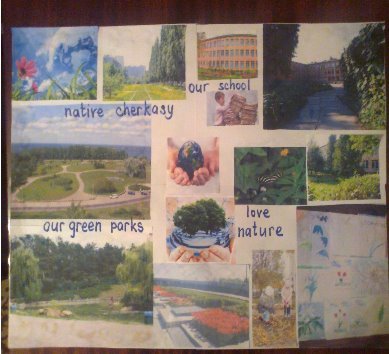


про публікацію авторської розробки
Додати розробку
